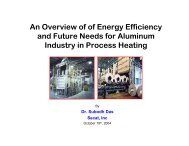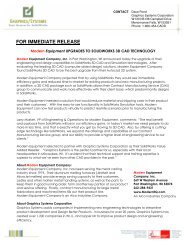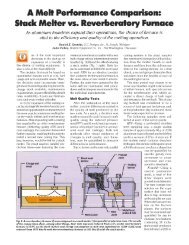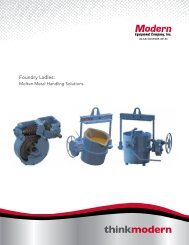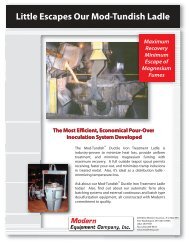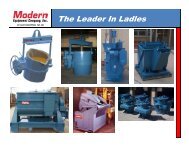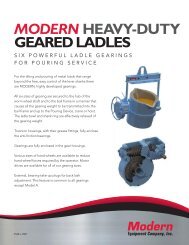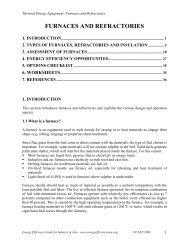ITP Metal Casting: Advanced Melting Technologies: Energy Saving ...
ITP Metal Casting: Advanced Melting Technologies: Energy Saving ...
ITP Metal Casting: Advanced Melting Technologies: Energy Saving ...
Create successful ePaper yourself
Turn your PDF publications into a flip-book with our unique Google optimized e-Paper software.
Cokeless Cupola: Iron is melted in this cupola<br />
using fuels such as natural gas, propane, diesel<br />
oil or pulverized coal in place of coke. Although<br />
invented over 30 years ago, only a few large<br />
foundries in Europe and India have adopted the<br />
technology. A water-cooled grate supports<br />
specially developed refractory spheres, which<br />
act as heat exchangers in a cokeless cupola<br />
(Exhibit 11). Below the grate are burners, which<br />
are operated to impart partially reducing<br />
conditions inside the cupola to reduce oxidation<br />
losses. The hot gases from the burners maintain<br />
the bed of spheres at high temperature, and<br />
preheat and melt the scrap in the shaft. The<br />
metal is superheated in passing through the bed<br />
and is then collected in the well prior to tapping.<br />
A carburizer is continually injected into the well<br />
13<br />
Source: DOE, EERE <strong>Energy</strong> Environmental Profile of the<br />
U.S. <strong>Metal</strong> <strong>Casting</strong> Industry<br />
Exhibit 11: Cokeless gas-melting<br />
cupola<br />
to give the correct carbon analysis. Elimination of coke decreases the CO content in the waste<br />
gas to 1%, indicating more efficient energy use when compared with the 12 to 20% CO emission<br />
typical in a conventional cupola. Use of cokeless cupolas simplifies the emission control system<br />
and results in lower sulfur content in metal and reduced slag production.<br />
Cokeless cupolas are typically operated at relatively low tapping temperatures of about 1,400 o C<br />
(2,550°F) to extend the refractory life, followed by superheating and re-carburization in an<br />
electric furnace. Cokeless cupolas duplexing through electric furnaces are presently in use in<br />
Germany, Spain, Japan, Austria, and Korea. In terms of energy efficiency, a typical cold blast<br />
cupola averaging 12% coke consumption and 1,450°C (2,640°F) tap temperature effectively<br />
utilizes 40% of the energy input while a cokeless cupola with natural gas consumption of 50<br />
Nm 3 /t (1,770Nft 3 /t) and an iron temperature of 1,380°C (2,520°F) utilizes 72% of the available<br />
energy. 20<br />
4.1.3 Electric Arc Furnaces<br />
Steel automobile shredded scrap with high residual elements and virgin iron raw materials, such<br />
as direct reduced iron, are difficult to melt efficiently in a cupola or coreless induction furnace.<br />
Cupola melting requires clean steel scrap and coke, materials that are becoming increasingly<br />
scarce and expensive. Electric arc furnaces are well suited for these purposes. Almost 87% of the<br />
electric arc furnaces are used to melt steel (or iron and steel) and 13% to melt iron. 21<br />
Electric arc furnace uses electrodes that are lowered to strike an arc on the cold scrap; the<br />
electrical system automatically controls the level of the electrode, lifting and lowering each<br />
individual electrode according to the electrical settings. The arc provides heat by radiation and<br />
current resistance (through the metal) to melt the scrap. 22 An intrinsic advantage of electrical<br />
heating is the lower metal loss.



